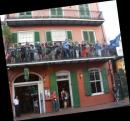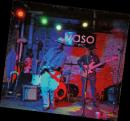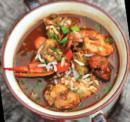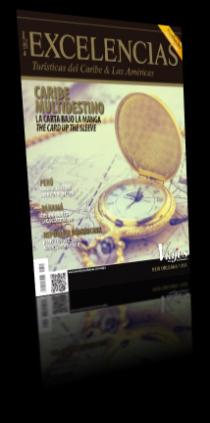- Let the good times roll.
The literal translation of this French-origin Cajun expression, widely used during the Mardi Gras carnival, conveys its actual meaning. It’s used in the spirit of “let the party go on forever”.
People say you haven’t been to Nawlins if you haven’t seen the Mardi Gras or the French Quarter, of haven’t tasted any of the highly-spiced Cajun treats. People say you know nearly nothing about NOLA if you haven’t had the palm of your hand read by any of the voodoo fortunetellers. The fact is that few things escape the motley history of the Satchmo’s Louisiana… The Excelencias magazine visited this real-marvelous city during the 2016 International Pow Wow and we were simply dazzled by some of its charms. Come and unravel them with us through these postcards presented by Travels by Excelencias…
French Quarter: Love is in the Air
This is not only the city of New Orleans’ oldest side, but also the most picturesque and, therefore, the number-one travel destination in town. Multicolor flags proudly trumpet the diversity you can breathe in every nook and cranny of this barrio, a neighborhood that expanded around the former French square, but whose buildings were built in the 18th century, amid the Spanish colonization. The New Orleans’ Great Fire of 1788 played havoc with most of the olden French colonial architecture, a reason why the Spanish style of gaudy walls and roofs stretched out, and so did the balconies and galleries spruced up with wrought-iron grates of elaborate decoration.
Mardi Gras or Joy as a Rule
The so-called “Grease Tuesday” refers to the last day to revel in both culinary and carnal pleasures during the time of abstinence that marks the beginning of the Holy Week and Lent. The Mardi Gras’s traditional colors are purple, yellow, gold and green. Word has it those hues were selected in 1892 when the Rex Parade brought up the meanings of colors as the theme for their floats. Purple is linked to justice, green to faith and gold to power.
Necklaces on Bare Breasts
They are tossed from the balconies to those who march down the street during the Mardi Gras. As a token of “appreciation”, women in the streets flash their breasts lightheartedly. This tradition –the festival just can’t do without it- harkens back to the 19th century. Students, hippies, LGBTIQs and people from all over the world gather in NOLA to join the festivities.
Spanish Streets
This is a curiosity in NOLA. The streets formerly known for their Spanish names still keep these banners with the old monikers carved in them, without any translation into French or English. Some cases in point are Calle Real, Calle De Borbon, Calle Del Maine and many more.
New Orleans African American Museum
The New Orleans Museum of African American Art, Culture and History is a must in all historic tourism itineraries across the United States. The great maison de maître, built circa 1828 and 1829, seeks to educate and promote African culture among NOLA residents, descendants of both slaves and freedmen who played a part in the emancipation and independence of the United States of America.
Where is it? In the oldest African-origin community of the U.S., in the neighborhood of Tremé: 1418 Governor Nicholls St, New Orleans.
Voodoo Museum: Fate in your Hands
With a sober yet flashy ambience, the Historic Voodoo Museum is a small locale devoted to the history of the voodoo religion. Founded by Jerry Gandolfo back in 1972, the place showcases instruments and artifacts used by the voodoo sorceresses. African woodcarvings, voodoo dolls and offerings to Marie Laveau (the queen of voodoo in New Orleans) are some of the objects tourists photograph the most.
Where is it? Right in the heart of the French Quarter: 724, Dumaine St, New Orleans.
Music in the Soul of a City
Louis Armstrong, Dixie Guillespie, Fats Domino, Winston Marsalis… you name it. The list could go on and on. New Orleans has been the birthplace and magnet of the most freely-rhythmic music ever heard.
Where can you hear the best nawlins music? The most celebrated clubs are the Spotted Cat Music Club, the Frenchman Street Jazz Club and the Maison Bourbon, but in all bars and nightclubs visitors can listen to good live music.
Cajun and Creaole Food: Very Hot!
Cajun cuisine comes down from the traditional cooking of French-Canadian migrants that had been expelled from the region of Arcadia after the French territories in Canada were seized by the British Crown. Aromatic vegetables such as peppers, onions and celery are labeled by some chefs as the holy trinity of Cajun gastronomy.
Creole food, for its part, hails from Louisiana –especially in the zone of New Orleans- and features blends of French, Spanish, Italian, Caribbean, African and American cuisine. It vaguely resembles Cajun gastronomy as far as ingredients are concerned –such as the holy trinity-, yet it’s characterized by the use of peppers, tomatoes and the juice of citrus fruits in marinated meats, let alone rice and the addition of navy beans.
Do you know the factory of the famous Tabasco-brand hot sauce is located in Louisiana? Even though the name stems from the Mexican state of Tabasco, it’s indeed a product manufactured by McIlhenny Company, the one that makes all the hot sauce of this kind sold worldwide from its headquarters in Iberia Parish, Louisiana. The product is on sale in 165 countries.







































































































































